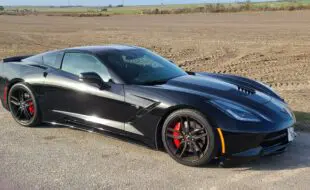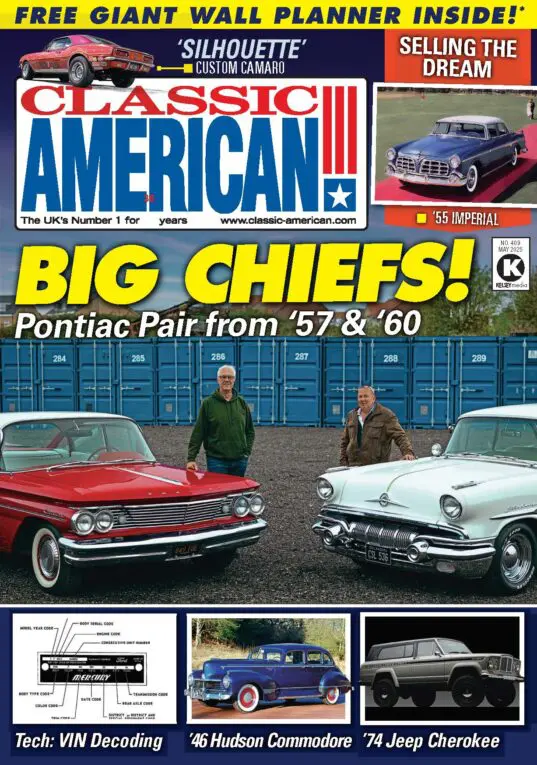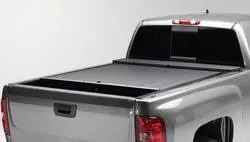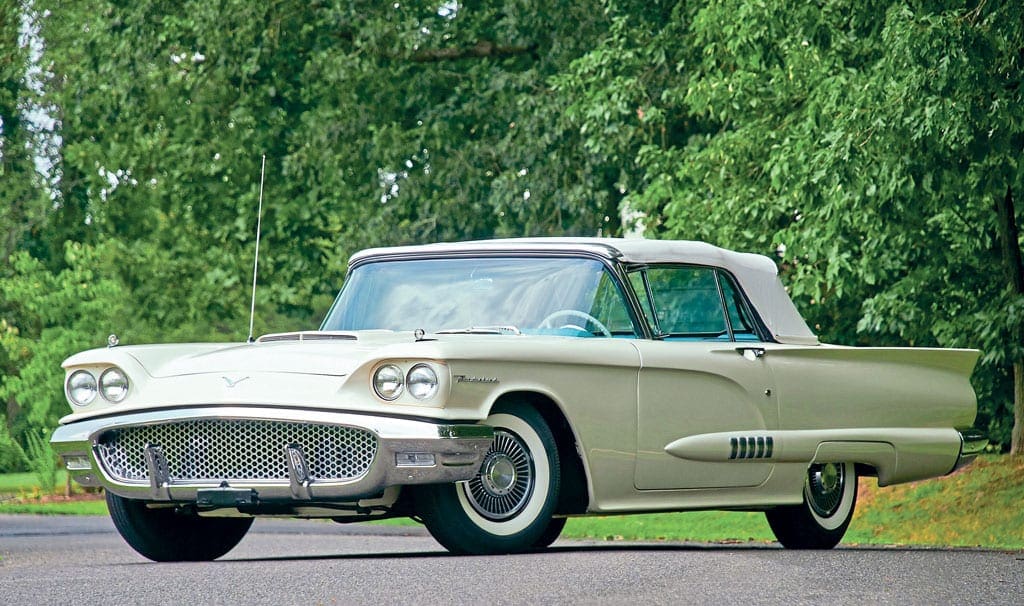
Jim Maxwell examines what many consider to be America’s first truly mass-produced personal luxury car: the second-generation Ford Thunderbird…
The Ford Thunderbird debuted in 1955 as a two-seater ‘personal car’ and was Ford Motor Company’s answer to the Chevrolet Corvette. It easily outsold the cross-town rival (16,155 T-birds to just 674 Corvettes).
Robert McNamara, who was one of the original ‘Whiz Kids’ (a group of 10 United States Army Air Force veterans that in 1947 had come to Ford in response to an offer to become part of the upper management) had become general manager of Ford. McNamara was not a ‘car guy’; however, he knew the important numbers that went with the car business.
Enjoy more Classic American reading in the monthly magazine.
Click here to subscribe & save.
While the Thunderbird, as Ford’s flagship car, did wonders in helping provide an exciting way to get people into the dealership showrooms, its sales were not really enough to make any significant profit from. Chevrolet was barely selling its Corvette, which was marketed as a sports car, and while Ford was selling the T-bird in larger numbers, it was clear to McNamara that something had to be done, and quickly.
The decision was made to build a four-seater Thunderbird. The Ford engineers assigned to the project initially had planned to incorporate a traditional body-on-frame design like the original car, and with a stretched wheelbase to accommodate the increased seating. However, once these engineers caught a glimpse of what the Lincoln Division was working on – the new Lincoln Premiere for 1958, which featured unibody construction – the plans were changed.
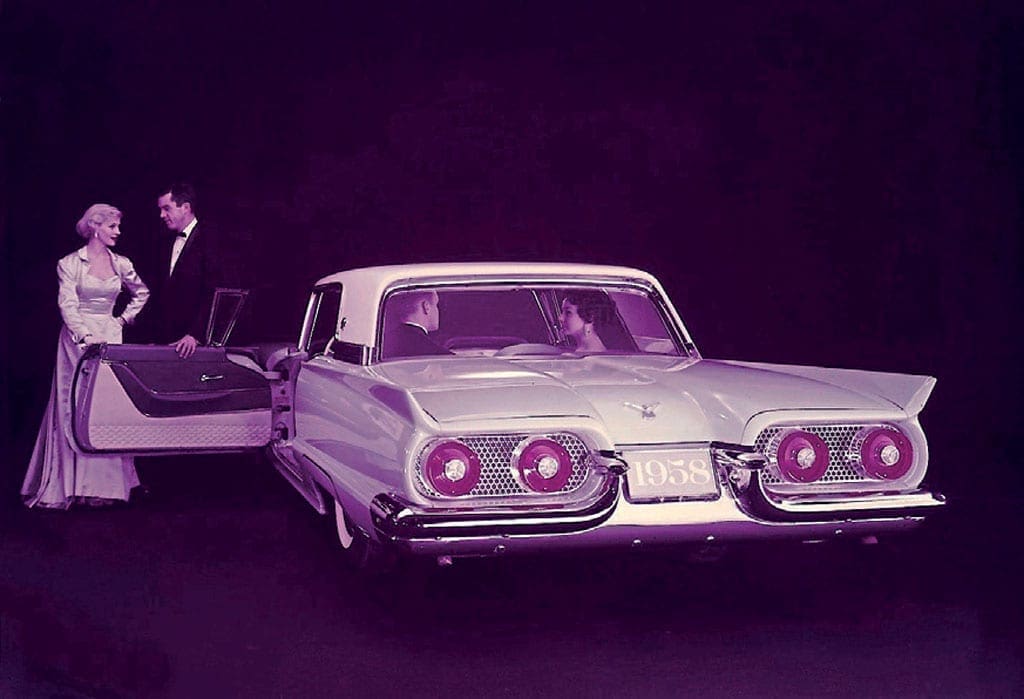
The building of the new, larger Thunderbird as a unibody car would help save the company money (by utilising the Lincoln manufacturing facility, a brand-new assembly plant in Wixom, Michigan). This move would allow the car to sit lower to the ground, with the desired low profile as a result of not having a traditional frame.
It should be pointed out that the use of unibody construction didn’t make the larger Thunderbird any lighter (as compared to had it been built the previous way), it was a new manufacturing trend that FoMoCo was getting involved with.
The new Thunderbird was unveiled on January 13, 1958, which was about two months after the rest of the Ford 1958 model year cars. The new shape was angular, elegant and distinctive in appearance. The overall shape of the car was not over-decorated, but crisp and clean, and to understand how different the T-birds looked, you have to remember the styling of that era and how heavily ornamented the average American car was at the time.
It had flowing lines and was some 11 inches longer and nearly 1000lb heavier, but it comfortably seated four adults, which was the whole point. The wheelbase was now 113 inches, 11 inches longer than the 1957 model, and the interior was incredibly spacious, especially considering the designers reduced the overall height by nearly 10 inches.
Because everything was so low (they were able to lower the car’s overall ground clearance to 5.8 inches), the driver and front passengers were just 12 inches off the ground.
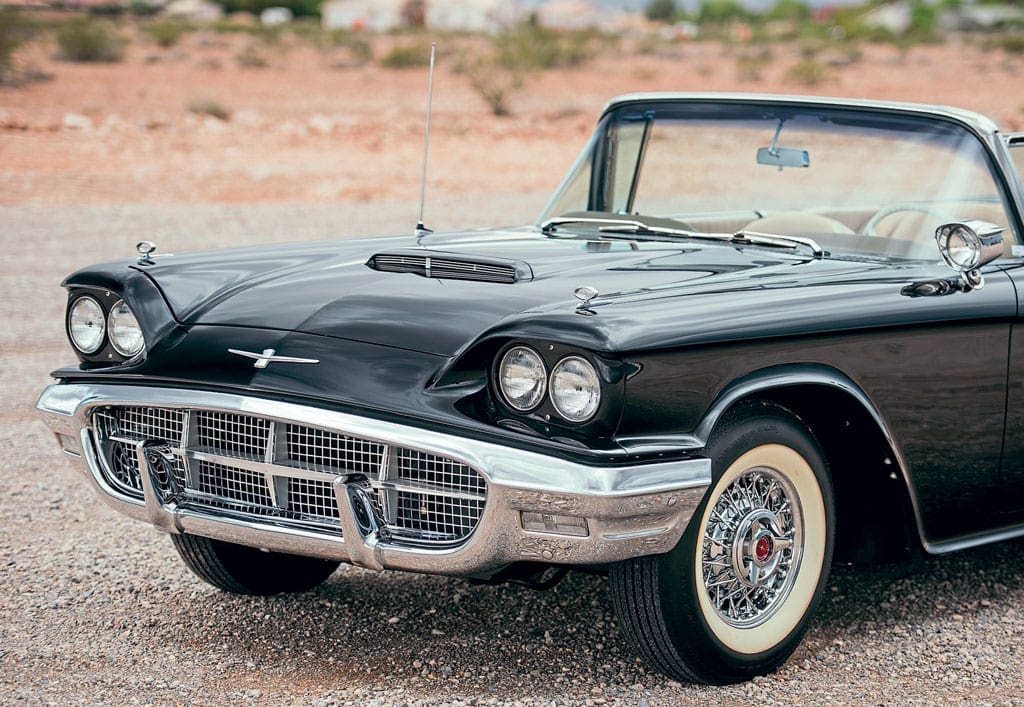
Under the skin
The front suspension system ended up being the traditional coil spring suspension arrangement with unequal-length A-arms, with a front sway bar. One unique ‘one-year-only’ feature of the 1958 Thunderbird was the rear suspension layout – there was an innovative air cushion ride system (the factory called it ‘Ford-Aire’) that was planned, so the car was equipped with something Ford vehicles were not known for at the time: rear coil springs.
The layout featured trailing arms used to locate the coils, and the reason for this set-up was to be able to facilitate optional air suspension by replacing the coils with air domes (which were planned to be optional equipment).
Unfortunately, the air suspension system proved to be unreliable (prone to air leaks, bladder bleed-down after the car was idling for extended periods of time) and it was not offered on Ford vehicles, except for a couple of hundred that were released before the problems were discovered. The next model year Thunderbirds were fitted with conventional parallel leaf springs.
The 1958 Thunderbird also featured an all-new powerplant. The design and engineering on the new, larger V8 (352cu in) engine was done largely by Ford’s chief engineer in their engine and foundry division, Robert Stevenson.
It was called the ‘FE’ engine family because it had versions specifically for Ford vehicles (332cu in and 352cu in) plus one exclusively for the Edsel, 361cu in. As fitted into the T-bird, the 352 engine featured a four-barrel carburettor and dual exhausts, developing 300 horsepower.
Also new for the second-generation T-bird was a brand-new Cruise-O-Matic automatic transmission, which was a three-speed unit that replaced the previous two-speed Ford-O-Matic version. There was also the availability of an overdrive-equipped three-speed manual transmission, for those that liked to shift themselves.
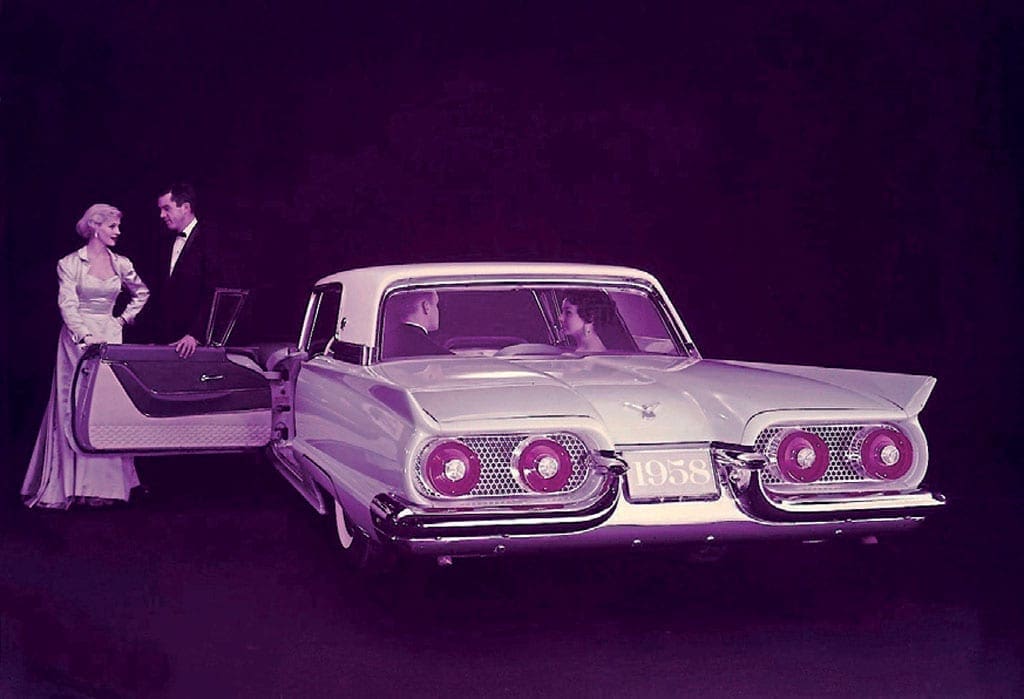
The interior of the car was quite innovative, as there was a compartmentalisation design theme that started with a sculpted dashboard (with matching driver/passenger enclosures) then continuing on with bucket seats and a centre console that ran the length to the rear seating areas. When you opened the doors, there was an abundance of space – the back seat was not cramped.
The use of a unibody structure combined with a low car necessitated a large tunnel for the transmission and driveshaft, and that also created a stronger assembly as it acted as a structural ‘spine’ for the car. The end result was that after it was fitted with an attractive full-length console, the interior flowed very naturally.
All the usual luxury-type options were available: power-windows, power-operated driver’s seat (four-way), power-brakes and power-steering, air conditioning and electric clock. The layout of the interior design launched the first ‘bucket-seat-and-centre-console personal car’ in the industry. Leather seats were also available as optional equipment. The trunk space was larger, now with 20sq ft of capacity, plus room for the spare tyre.
Whitewall tyres were the norm for people that purchased Thunderbirds, and they measured 21/4 inches wide (8.00 x 14 or optional 8.50 x 14); 11 x 21/2-inch drum brakes were used all round, and 10-inch hubcaps with blackwalls were standard. However most cars received the ‘Fashion Ray’ – full wheel covers with whitewall tyres.
It wasn’t until June of 1958 that the factory was able to produce convertible Thunderbirds. Owners with drop top cars had very little room for any cargo as the folding mechanism took up most of the space.
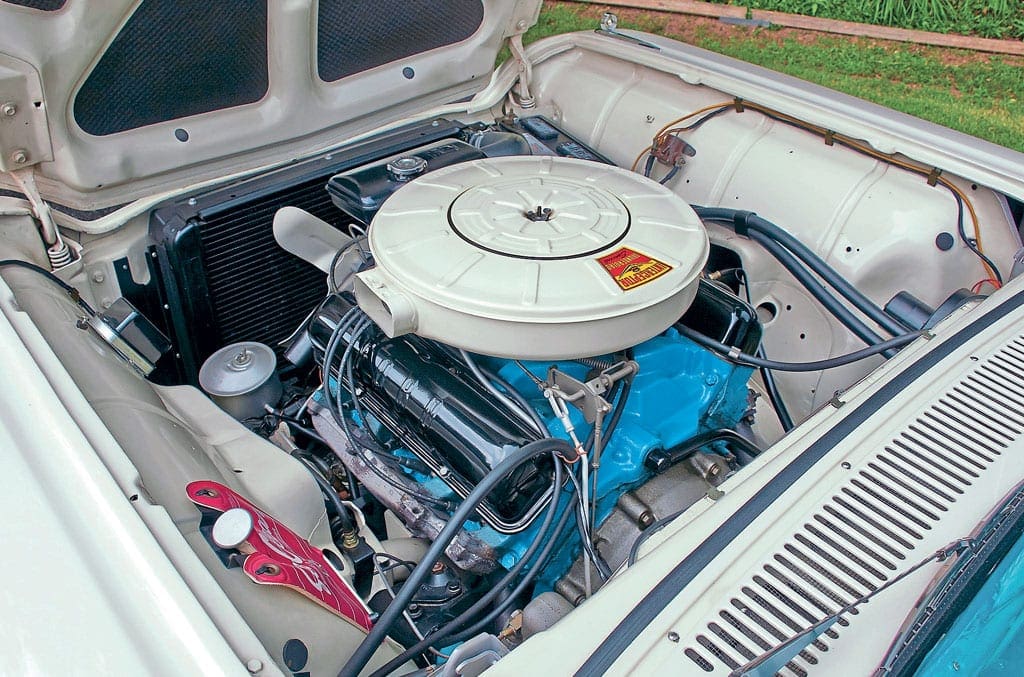
Success story
To say the four-seater 1958 Thunderbird was a success is an understatement – 37,892 were sold that first year, an impressive number considering it was a year of economic recession in America, plus it had that late introduction date.
With the convertible model being delayed until mid-year, just 2134 were built. Overall, the 1958 T-Bird had a 76% sales jump as compared to the 1957 Thunderbird models. Significantly, Motor Trend magazine named it Car of the Year.
In 1959 a new, more powerful powerplant was made an option available to Thunderbird owners, a 430cu in V8 from the MEL (Mercury, Edsel, Lincoln) engine family (Mercury versions 383cu in and 430cu in, Edsel version 410cu in).
This was a physically larger engine (featuring 4.90-inch bore centres as compared to the FE 4.63-inch bore centres), while it also incorporated a front distributor and deep-skirted engine block design.
The 430cu in Thunderbird powerplant (J-Code) developed 350 horsepower at an impressive 490ft-lb of torque at 2800rpm. Like the 352 FE Thunderbird engines, it came with dual exhausts; however, these big-inch powerplants also had resonators.
Cosmetically, very little was changed on the 1959 cars, save for chrome added on the door spears and the Thunderbird script being relocated from the front fenders to the doors. Customers widely accepted the car, as is, and sales jumped to 67,456 (10,261 of them being convertibles).
For 1960, the 430-cid engine option now had a compression ratio of 10.2:1, while the horsepower rating remained at 350. Minor trim changes were made and despite the Thunderbird being on its last year of the styling cycle, it turned out to be a banner year for Thunderbird as the sales shot up to 98,798 total cars sold.
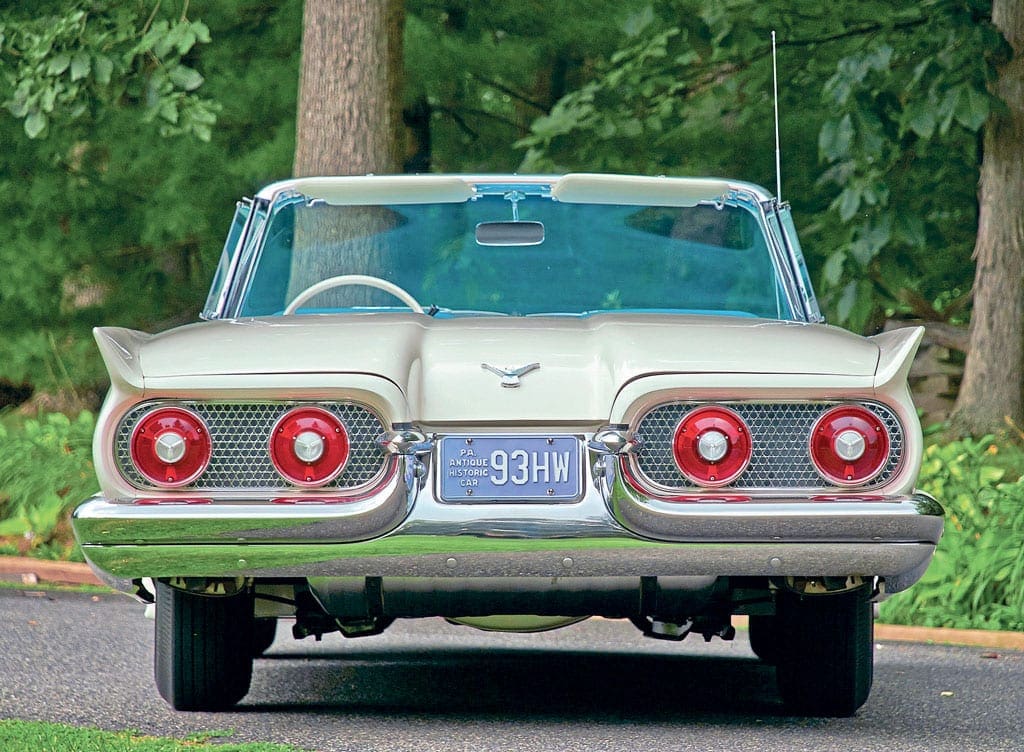
With a record amount of 1960 Thunderbirds rolling out of Ford dealerships that year, it was a true testament to the success of the overall concept of the vehicle as America’s first mass-produced ‘personal luxury car’.
Discounting those that loved the car in its early years as a two-seater, Ford Motor Company hit a major home-run with the Square Bird. It was a risk of sorts to double the seating arrangement of the car, perhaps; however, it was a gamble that greatly paid off. History confirms that the second-generation angular-shaped Thunderbirds are considered true design masterpieces to this day.


